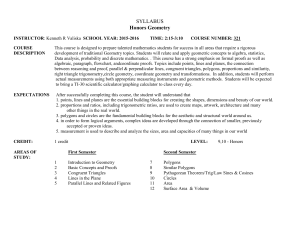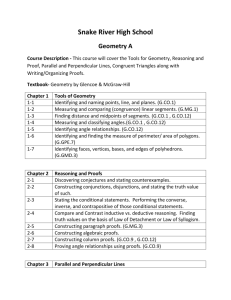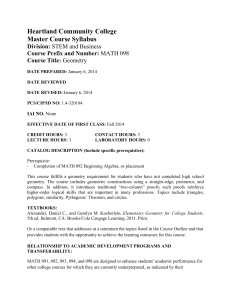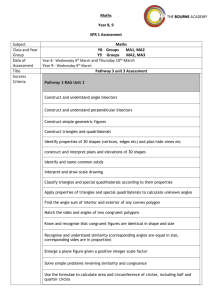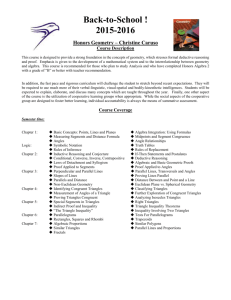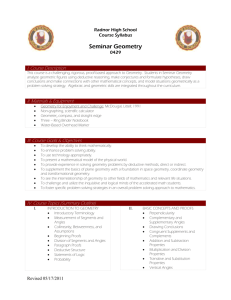June 2004 High School Mathematics Honors Geometry This is an
advertisement
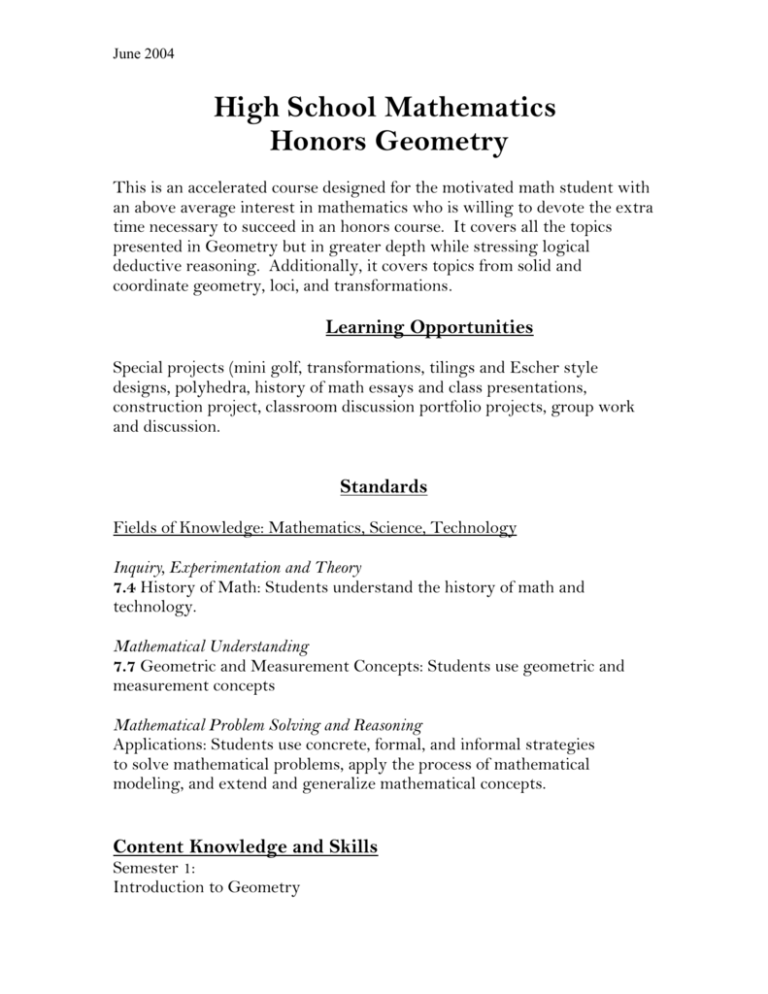
June 2004 High School Mathematics Honors Geometry This is an accelerated course designed for the motivated math student with an above average interest in mathematics who is willing to devote the extra time necessary to succeed in an honors course. It covers all the topics presented in Geometry but in greater depth while stressing logical deductive reasoning. Additionally, it covers topics from solid and coordinate geometry, loci, and transformations. Learning Opportunities Special projects (mini golf, transformations, tilings and Escher style designs, polyhedra, history of math essays and class presentations, construction project, classroom discussion portfolio projects, group work and discussion. Standards Fields of Knowledge: Mathematics, Science, Technology Inquiry, Experimentation and Theory 7.4 History of Math: Students understand the history of math and technology. Mathematical Understanding 7.7 Geometric and Measurement Concepts: Students use geometric and measurement concepts Mathematical Problem Solving and Reasoning Applications: Students use concrete, formal, and informal strategies to solve mathematical problems, apply the process of mathematical modeling, and extend and generalize mathematical concepts. Content Knowledge and Skills Semester 1: Introduction to Geometry June 2004 Basic concepts and proofs Congruent triangles Lines in the plane Parallel lines and related figures Lines and planes in space Semester 2: Polygons Similar polygons The Pythagorean Theory Circles Area Surface areas and volume Miscellaneous topics inserted throughout the year (three dimensional graphing and reflections, rotational, reflectional and transformational symmetry, fourth dimensional analysis with the reading of Flatland, coordinate geometry, spherical geometry, locus and compound locus, advanced construction projects, triangle inequalities) Assessment Criteria 1. Introduction to Geometry: Students are able to: identify types of angles and perform measurement understand collinearity, betweenness and assumptions perform beginning proofs know division rules of segments and angles form paragraph proofs create and apply a deductive structure understand statements of logic, syllogisms know the basic rules of probability 2. Basic Concepts and Proofs Students are able to: understand rules of perpendicularity work with complementary and supplementary angles draw conclusions based on given information apply addition and subtraction properties to proof apply multiplication and division properties to proof apply transitive and substitution properties to proof June 2004 identify and use the properties of vertical angles construct perpendicular lines (from a point on a line, not on a line), angle bisection, segment bisection, complementary angles, copying angles based on basic geometric concepts 3. Congruent triangles Students are able to: define congruent figures learn and apply the four ways to prove triangles congruent (ASA,SSS,SAS,AAS) extend their knowledge of triangles with corresponding parts of congruent triangles are congruent (CPCTC), and intro to circles and double proofs going beyond CPCTC work with overlapping triangles identify all types of triangles identify and use the hypotenuse-leg postulate construct triangles given parts of triangles, constructing points of concurrence (centroid, orthocenter, incenters and circumcenters) 4. Lines in the Plane Students are able to: create proofs involving detours and midpoints solve missing diagram proofs understand and apply the right angle theorem and equidistance theorems define and work with parallel lines and slope construct of parallel lines given a line and a point on the line. 5. Parallel lines and related figures Students are able to : understand and solve indirect proofs prove that lines are parallel identify angle sets and their relationship in angles associated with parallel lines identify types of quadrilaterals and know their properties prove that quadrilateral is a parallelogram prove that figures are special quadrilaterals (rhombus, kite, rectangle, square) 6. Lines and planes in space Students are able to: relate lines to planes June 2004 understand perpendicularity of a line and plane know the basic facts about parallel planes draw three dimensionally on isometric and orthographic paper 7. Polygons Students are able to: understand the triangle application theorems and formulas identify the various common regular polygons work with tiling, Escher type drawings 8. Similar polygons Students are able to: continue to work with ratio, proportion and similarity as applied to Geometry utilize methods of proving triangles similar use congruence and proportions in similar triangles 9. The Pythagorean Theorem Students are able to: work with radicals and quadratic equations understand basic facts about circles learn and apply the altitude-on-hypotenuse theorems learn and apply the Pythagorean Theorem apply the distance formula learn and apply families of right triangles and special right triangles apply the Pythagorean Theorem and Space Figures learn and apply the trigonometric ratios (sine, cosine, tangent) 10. Circles Students are able to: identify parts of a circle, including congruent chords, arcs of a circle, secants and tangents, and angles related to a circle learn and apply the arc theorems learn and apply the power theorems work with circle circumference and arc length, pi construct tangents June 2004 11. Area Students are able to: understand area find the areas of parallelograms and triangles, trapezoids, kites and related figures, regular polygons, circles find the area of sectors, segments of circles find and work with the ratios of areas use Hero’s and Brahmagupta’s formulas to find the area of a figure given just sides of the figure 12. Surface areas and volume Students are able to: calculate surface areas of prisms, pyramids, circular solids calculate volumes of prisms, pyramids, cones and cylinders calculate volume and surface area of spheres identify and calculate the ratio of volumes identify and construct polyhedron, use Euler’s formula Resources Text: Geometry for Enjoyment and Challenge - Rhoad, Milauskas and Whipple (McDougla, Littell) 1

